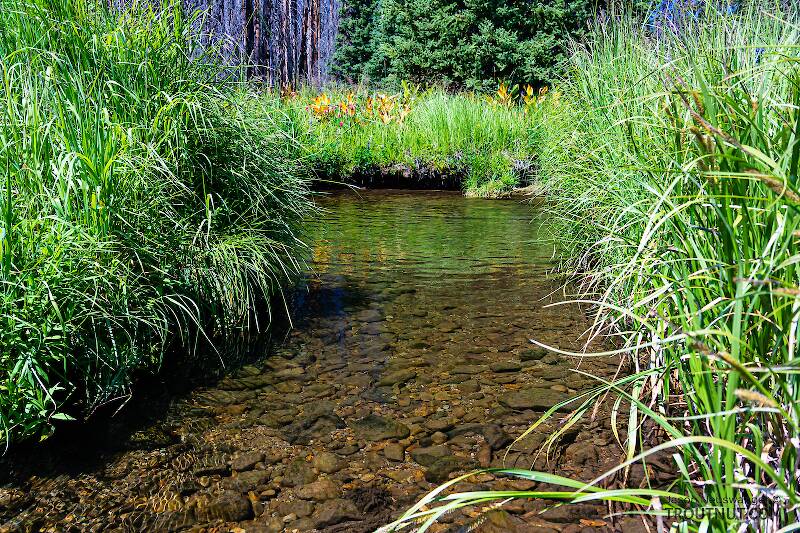
Salmonflies
Pteronarcys californica
The giant Salmonflies of the Western mountains are legendary for their proclivity to elicit consistent dry-fly action and ferocious strikes.
Featured on the forum

This one seems to tentatively key to Holocentropus, although I can't make out the anal spines in Couplet 7 of the Key to Genera of Polycentropodidae Larvae nor the dark bands in Couplet 4 of the Key to Genera of Polycentropodidae Larvae, making me wonder if I went wrong somewhere in keying it out. I don't see where that could have happened, though. It might also be that it's a very immature larva and doesn't possess all the identifying characteristics in the key yet. If Holocentropus is correct, then Holocentropus flavus and Holocentropus interruptus are the two likely possibilities based on range, but I was not able to find a description of their larvae.

Troutnut is a project started in 2003 by salmonid ecologist Jason "Troutnut" Neuswanger to help anglers and
fly tyers unabashedly embrace the entomological side of the sport. Learn more about Troutnut or
support the project for an enhanced experience here.
Identification: Key to Genera of Glossosomatidae Larvae, Couplet 4
Identification: Key to Genera of Glossosomatidae Larvae, Couplet 4
Error: Tried to access a key that isn't live.
Adapted from Merritt R.W., Cummins, K.W., and Berg, M.B. (2019)
This couplet refers figures (usually designated 'sf') from this source.
You will need the source (make sure to get the same edition!) to see them.
This couplet refers figures (usually designated 'sf') from this source.
You will need the source (make sure to get the same edition!) to see them.
| Option 1 | Option 2 |
|---|---|
| Basal seta of each tarsal claw long, thin, and arising from side of stout basal process (sf 19.163) | Basal seta of each tarsal claw short and stout, larger than basal process (sf 19.162) |
| Case constructed with some relatively large stones (sf 19.167) | Case constructed of uniformly small stones (sf 19.168) |
| Widespread | Northwest, West |
| Protoptila | Culoptila |
Adapted from Merritt R.W., Cummins, K.W., and Berg, M.B. (2019)
The current couplet is highlighted with darker colors and a icon, and couplets leading to this point have a icon.
Leads to Couplet 2:
- Mesonotum with 2 or 3 sclerites (sf 19.156, 19.157, sometimes hard to see)
- Head with ventromesal margins of genae not thickened
- Posterior median ventral ecdysial line about 1.5 times as long as each anterior divergent branch (sf 19.159, 19.160)
- Anal opening without dark, sclerotized line on each side
Couplet 2
Leads to Couplet 5:
- Mesonotum without sclerites
- Head with ventromesal margins of genae thickened
- Posterior median ventral ecdysial line about as long as each anterior divergent branch (sf 19.158)
- Anal opening with dark, sclerotized line on each side (sf 19.60, 19.164)
Couplet 5
Leads to Padunia
(Padunia jeanae):
(Padunia jeanae):
- Each tarsal claw apparently trifid, with 3 points subequal in length (sf 19.161)
- Southeast
Padunia
(Padunia jeanae)
(Padunia jeanae)
Leads to Couplet 4:
- Each tarsal claw with normal single point, basal seta and basal process much smaller (sf 19.162, 19.163)
Couplet 4
Couplet 4 (You are here)
Leads to Protoptila:
- Basal seta of each tarsal claw long, thin, and arising from side of stout basal process (sf 19.163)
- Case constructed with some relatively large stones (sf 19.167)
- Widespread
Leads to Glossosoma:
- Pronotum excised 1/3rd anterolaterally to accommodate coxae (sf 19.165)
- Dome-like case of stones with transverse ventral strap of finer sand and interchangeable ends (sf 19.38, 19.459a, 19.459b)
- Widespread
Leads to Anagapetus:
- Pronotum excised 2/3rds anterolaterally to accommodate coxae (sf 19.166)
- Case similar to that at left
- West
Anagapetus
Start a Discussion of this Couplet
References
- Merritt R.W., Cummins, K.W., and Berg, M.B. 2019. An Introduction to the Aquatic Insects of North America (Fifth Edition). Kendall/Hunt Publishing Company.

